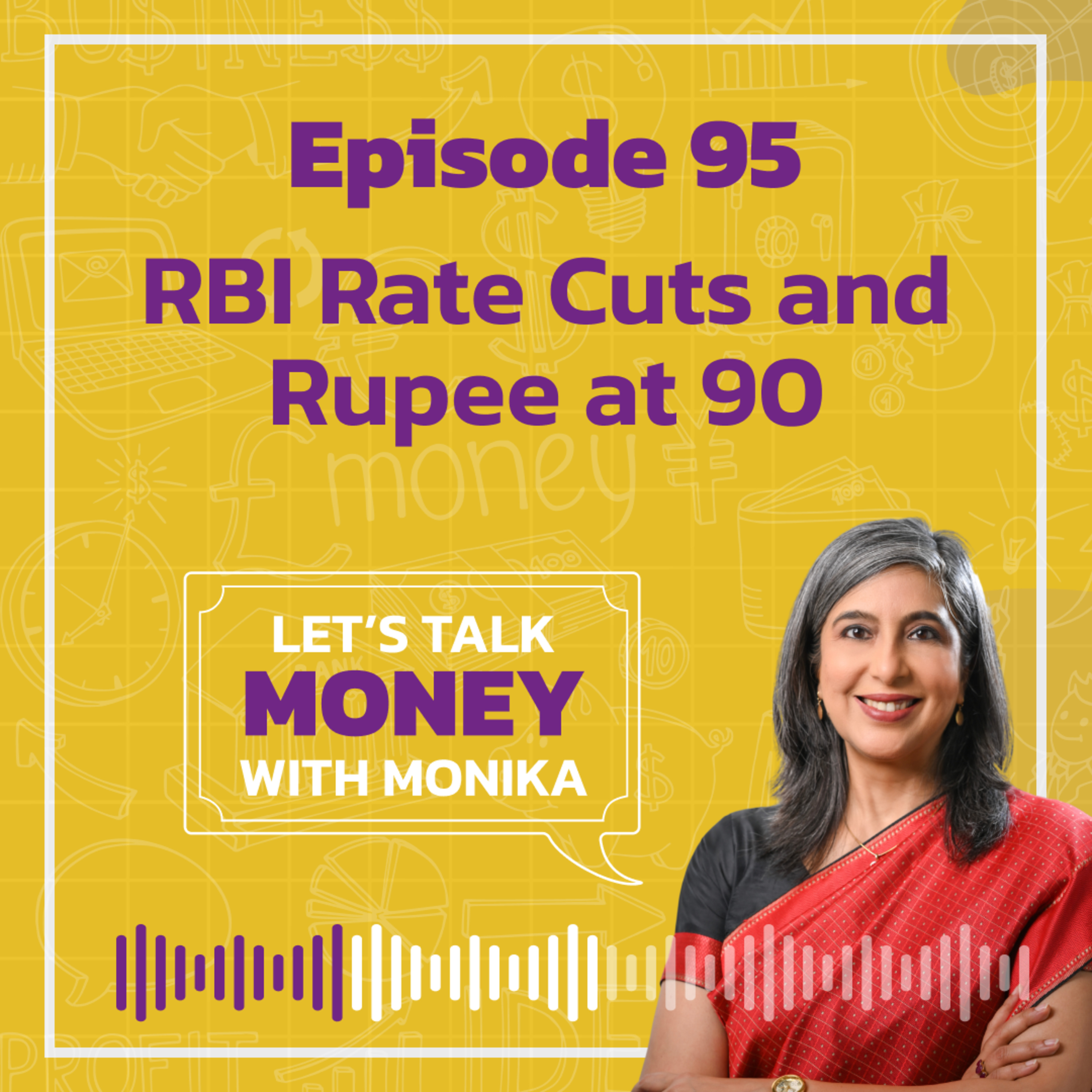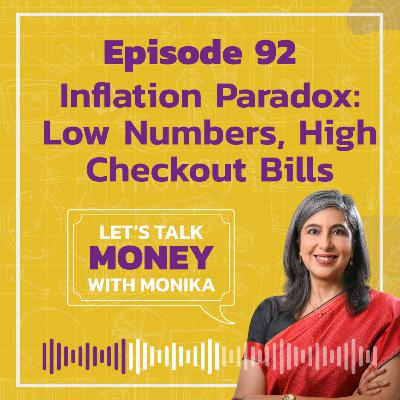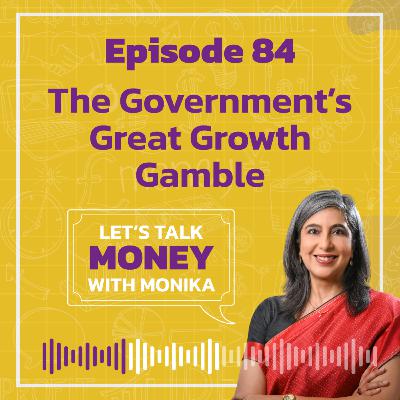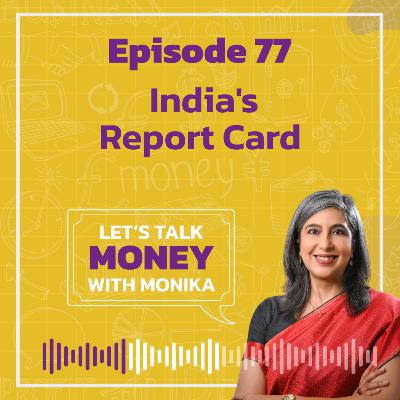Discover Let's Talk Money with Monika Halan
Let's Talk Money with Monika Halan

Let's Talk Money with Monika Halan
Author: Monika Halan
Subscribed: 136Played: 2,203Subscribe
Share
© Monika Halan
Description
Let's Talk Money is your guide to financial stability and freedom. Join Monika Halan, a trusted financial expert, as she delves into a wide array of topics each week. From tackling debt to making friends with the stock market, from gold to mutual funds, Monika's insights are your compass to financial wellness.
But that's not all! Monika's here to answer your money questions. Send them in, and she'll help you make informed decisions.
It's time to take control of your financial destiny with Monika Halan. So, Let’s Talk Money!
But that's not all! Monika's here to answer your money questions. Send them in, and she'll help you make informed decisions.
It's time to take control of your financial destiny with Monika Halan. So, Let’s Talk Money!
100 Episodes
Reverse
This week, Monika unpacks a busy stretch of economic headlines: a strong 8.2% GDP print, the rupee slipping to 90 against the dollar, and a 0.25% RBI rate cut. She begins by explaining why exchange rates matter, what drives currency demand, and why the recent rupee depreciation reflects global risk aversion, high US rates, and a seasonal widening of the current account deficit. Drawing on economist Sajjid Chinoy’s view, Monika highlights how a softer rupee can improve export competitiveness and why exceptionally low inflation gives the RBI confidence to allow the currency to adjust without triggering instability.Monika then explains how the RBI’s rate cut fits into the broader macro picture. With the repo rate now at 5.25%, the combination of strong growth, a gently depreciating rupee, and lower rates signals confidence in inflation staying anchored. She outlines what this means for savers and borrowers: FD and RBI bond investors may want to lock in long tenors while real returns remain high, borrowers should see relief ahead, and long-duration debt funds may offer tactical opportunities. Above all, she reminds listeners that stable financial plans should not be derailed by headlines or market noise.In listener questions, Anonymous from Bengaluru seeks guidance on navigating family wealth differences while choosing a life partner, Akila weighs renting versus buying as she plans a move before eventually settling into a retirement home, and Aravind from Kerala asks whether investing across top democratic countries is practical for an Indian investor.Chapters:00:00 – 00:00) RBI Rate Cuts and the Rupee at 90(00:00 – 00:00) Why the Rupee Fell and What It Means for Inflation(00:00 – 00:00) Navigating Marriage Decisions When Families Differ in Wealth(00:00 – 00:00) Choosing Between Renting, Buying, or Retirement Homes(00:00 – 00:00) Should Indians Invest Internationally? Practical Global Diversificationhttps://www.youtube.com/watch?v=9897cGJP0wAIf you have financial questions that you’d like answers for, please email us at mailme@monikahalan.com Monika’s book on basic money managementhttps://www.monikahalan.com/lets-talk-money-english/Monika’s book on mutual fundshttps://www.monikahalan.com/lets-talk-mutual-funds/Monika’s workbook on recording your financial lifehttps://www.monikahalan.com/lets-talk-legacy/Calculatorshttps://investor.sebi.gov.in/calculators/index.htmlYou can find Monika on her social media @monikahalan. Twitter @MonikaHalanInstagram @MonikaHalanFacebook @MonikaHalanLinkedIn @MonikaHalanProduction House: www.inoutcreatives.comProduction Assistant: Anshika Gogoi
This week, Monika breaks down the surprising 8.2% GDP growth print for India’s July–September quarter, and why the cheer hasn’t shown up in the stock market. She revisits the GDP formula and unpacks the drivers — strong private consumption, resilient services growth, a manufacturing boost from PLI schemes and GST cuts, and a surge in MSME credit that signals broad-based momentum. With India on track for ~7.5% growth this year, the fastest among major economies, Monika explains why this is solid, real activity rather than price-led nominal growth, and how that strength is built on rural spending, good monsoons and recent tax breaks.Monika then turns to the puzzle of why markets remain flat despite a booming economy. She outlines three reasons: money being pulled into IPOs, gold and silver instead of the secondary market; exceptionally low inflation reducing the GDP deflator and therefore nominal growth (the number that drives corporate revenues, profits and market valuations); and stretched valuations that still need cooling. Even so, she emphasises that long-term investors should stay disciplined, maintain asset allocation across debt and equity, and rebalance if needed — the structural growth story remains intact. She also previews next week’s discussion on the RBI’s rate decision and what it means for households.In listener questions, Shivam asks whether to prepay a low-rate education loan or invest aggressively, and how he and his wife should structure ₹1 lakh of monthly SIPs; Monika explains why, given their stability, keeping the loan and investing for growth works. Piyush writes in from a severe debt trap with home loans, personal loans and card dues far exceeding income; Monika urges him to involve family, liquidate assets and seek structured help through a debt resolution service. Anup, writing from Germany, wants to sell two residential plots and eventually buy a home in India; Monika points him toward Sections 54 and 54F, suggests consulting a CA on capital-gains planning, and outlines why a short-term loan followed by staggered asset sales may be practical.Chapters:(00:00 – 00:00) Why GDP Is Hot but Markets Are Cool(00:00 – 00:00) Understanding the Drivers Behind India’s Surprising Q2 GDP(00:00 – 00:00) EMI vs Investing: Navigating a Low-Interest Education Loan(00:00 – 00:00) Escaping a Debt Trap: Practical Steps When Repayments Overwhelm(00:00 – 00:00) Selling Plots or Taking a Loan: Smart Strategies for Buying a Home in Indiahttps://freed.care/ https://cleartax.in/s/section-54-capital-gains-exemption#h6If you have financial questions that you’d like answers for, please email us at mailme@monikahalan.com Monika’s book on basic money managementhttps://www.monikahalan.com/lets-talk-money-english/Monika’s book on mutual fundshttps://www.monikahalan.com/lets-talk-mutual-funds/Monika’s workbook on recording your financial lifehttps://www.monikahalan.com/lets-talk-legacy/Calculatorshttps://investor.sebi.gov.in/calculators/index.htmlYou can find Monika on her social media @monikahalan. Twitter @MonikaHalanInstagram @MonikaHalanFacebook @MonikaHalanLinkedIn @MonikaHalanProduction House: www.inoutcreatives.comProduction Assistant: Anshika Gogoi
This week, Monika unpacks one of the biggest economic reforms since 1991 — the newly implemented labour codes. She recounts a timely moment from recording the Groww-ing India podcast with Amitabh Kant, where a discussion on delayed labour reforms was followed, just hours later, by the government announcing full implementation. Monika explains why India’s post-independence socialist legacy created 29 overlapping, conflicting labour laws that made hiring, firing and compliance incredibly difficult, spawning “dwarf firms,” encouraging informality, and adding nearly 10% to product costs through routine procedural bribes. The new codes — covering wages, social security, industrial relations, and occupational safety & health — replace this maze with a far simpler, unified structure.Monika breaks down what changes for businesses, workers and the broader economy. Compliance sections drop by 75%, forms by 60%, and registers by 76%, with everything now digital. Unified definitions across laws reduce inspector discretion and bring transparency to how wages, benefits and severance are calculated. For workers, coverage expands beyond formal jobs to include gig and platform workers, with mandated timelines for wage payments and clearer rules on overtime. States can now raise the threshold for prior government approval on layoffs, potentially enabling large-scale manufacturing. Lower compliance costs should translate into better margins, fairer protections for informal workers, and eventually lower prices — feeding into higher growth and better long-term returns for investors. For most white-collar employees, the most immediate change may be a rise in delivery fees as gig-worker welfare contributions kick in.In listener questions, Mamta - a 50-year-old single woman between jobs - asks where to keep her savings safely. Sanjay, a 22-year-old data analyst saving an impressive 41% of his income, seeks help budgeting for a future Vietnam trip without derailing long-term investing. And Shikha, entering her 40s with a ₹1.5 crore corpus, wants clarity on buying a house versus renting and how to structure her retirement plan. Monika lays out practical paths for each situation, balancing caution with empowerment.Chapters:(00:00 – 00:00) What the new labour laws mean for you(00:00 – 00:00) Safe saving options when you can’t take risk(00:00 – 00:00) How to plan a holiday while investing aggressively(00:00 – 00:00) Should you buy a house or keep renting?(00:00 – 00:00) How to plan retirement when starting latehttps://www.youtube.com/@ThrivebyGrowwIf you have financial questions that you’d like answers for, please email us at mailme@monikahalan.com Monika’s book on basic money managementhttps://www.monikahalan.com/lets-talk-money-english/Monika’s book on mutual fundshttps://www.monikahalan.com/lets-talk-mutual-funds/Monika’s workbook on recording your financial lifehttps://www.monikahalan.com/lets-talk-legacy/Calculatorshttps://investor.sebi.gov.in/calculators/index.htmlYou can find Monika on her social media @monikahalan. Twitter @MonikaHalanInstagram @MonikaHalanFacebook @MonikaHalanLinkedIn @MonikaHalanProduction House: www.inoutcreatives.comProduction Assistant: Anshika Gogoi
This week, Monika breaks down the “inflation paradox” India is living through — where official inflation has collapsed to 0.25%, yet households still feel the pinch at checkout counters. She explains how the headline number hides a deeper story: if the impact of gold is removed from the Consumer Price Index, October inflation actually turns negative. An SBI Research estimate suggests that, excluding gold, inflation could remain below zero for the next two months. Food prices have fallen sharply, with vegetables down nearly 28% and pulses over 16%, creating a painful situation for farmers even as households see temporary relief.Monika unpacks why very low inflation is a problem for the wider economy. Weak prices signal weak demand, hurting production, wages and eventually jobs. Governments too suffer when inflation falls, because tax revenues depend on nominal — not real — growth. With the RBI’s full-year inflation estimate cut to 2.6%, the number now threatens to breach the lower bound of the 2–6% target band, raising the possibility of rate cuts. She also explains why lived inflation can feel higher than official data: lifestyle choices — app-based shopping, food delivery, eating out — inflate household budgets far more than the CPI basket. For savers and investors, a lower-trend inflation world means lower bank FD rates and more moderate long-term equity return expectations, making equity allocation essential for retirement planning.In listener questions, Srinivas seeks guidance on managing a large education loan, bundled insurance policies, and family assets; Sampath from the US weighs whether to buy property in Hyderabad now or after returning to India; and an anonymous listener asks how to secure term insurance after a past cancer diagnosis. Monika also gives a shout-out to Rinku Jain, who recently shifted from trading to financial education after being inspired by Let’s Talk Money.Chapters:(00:00 – 00:00) The Inflation Paradox: Why Low Numbers Still Feel Expensive(00:00 – 00:00) How Low Inflation Impacts Growth, Wages, Taxes & Your Investments(00:00 – 00:00) How to Fix a Costly Loan, Bundled Insurance & a Risky Family Portfolio(00:00 – 00:00) Should NRIs Buy Property Now or After Returning to India?(00:00 – 00:00) Can Cancer Survivors Get Term Insurance? What Your Real Options Arehttps://www.dropbox.com/scl/fi/ivlio9duh6yemspbdu6rm/Inflation-SBI-Report-Oct-2025.pdf?rlkey=n6fyqfssoz5tw88unhsx0sn3a&dl=0https://www.stcipd.com/UserFiles/File/Measuring_Trend_inflation_in_India-A_summary.pdfIf you have financial questions that you’d like answers for, please email us at mailme@monikahalan.com Monika’s book on basic money managementhttps://www.monikahalan.com/lets-talk-money-english/Monika’s book on mutual fundshttps://www.monikahalan.com/lets-talk-mutual-funds/Monika’s workbook on recording your financial lifehttps://www.monikahalan.com/lets-talk-legacy/Calculatorshttps://investor.sebi.gov.in/calculators/index.htmlYou can find Monika on her social media @monikahalan. Twitter @MonikaHalanInstagram @MonikaHalanFacebook @MonikaHalanLinkedIn @MonikaHalanProduction House: www.inoutcreatives.comProduction Assistant: Anshika Gogoi
This week, Monika unpacks SEBI’s recent caution to the public against dealing in digital gold. The regulator clarified that while SEBI oversees gold ETFs, commodity derivatives, and Electronic Gold Receipts — all backed by strict rules and physical verification — digital gold remains completely outside its supervision. That means investors have no legal protection if something goes wrong. Many platforms may not actually hold the gold they sell, exposing buyers to serious counterparty and fraud risks. Even though major brands like PayTM, Tanishq, and MMTC offer digital gold, these products are still unregulated.Monika explains how SEBI’s framework ensures transparency and security for gold ETFs — from mandatory physical holdings and custodian oversight to regular audits and purity checks. In contrast, digital gold lacks such verification, leaving investors unsure if the gold even exists. While the ease of purchase and small-ticket investments make digital gold tempting, SEBI’s warning is a timely reminder that convenience can come at a cost. Gold can still have a place in portfolios, but allocations should stay within 5–10%, and SEBI-regulated gold ETFs are the safer route for long-term investors.In listener questions, Anonymous seeks clarity on how to transition gradually from real estate and ESOPs into equity funds over the next decade, Vijay from Tamil Nadu asks how to begin crypto investing safely, and Padma, a retired investor, wants help streamlining her mutual fund portfolio and understanding the role of index and debt funds.Chapters:(00:00 – 00:00) Why You Should Not Buy Digital Gold(00:00 – 00:00) Planning a 9-Year Transition from Real Estate to Equity(00:00 – 00:00) Should You Invest in Cryptocurrency?(00:00 – 00:00) Building a Safe and Structured Investment Journey(00:00 – 00:00) How to Simplify Your Mutual Fund Choices in Retirementhttps://www.sebi.gov.in/media-and-notifications/press-releases/nov-2025/caution-to-public-regarding-dealing-in-digital-gold-_97676.htmlIf you have financial questions that you’d like answers for, please email us at mailme@monikahalan.com Monika’s book on basic money managementhttps://www.monikahalan.com/lets-talk-money-english/Monika’s book on mutual fundshttps://www.monikahalan.com/lets-talk-mutual-funds/Monika’s workbook on recording your financial lifehttps://www.monikahalan.com/lets-talk-legacy/Calculatorshttps://investor.sebi.gov.in/calculators/index.htmlYou can find Monika on her social media @monikahalan. Twitter @MonikaHalanInstagram @MonikaHalanFacebook @MonikaHalanLinkedIn @MonikaHalanProduction House: www.inoutcreatives.comProduction Assistant: Anshika Gogoi
This week, Monika sits down with India’s Chief Economic Adviser, Dr V. Anantha Nageswaran, for a wide-ranging conversation on governance, regulation, and the challenges of doing business in India. He explains why India must “reduce the cost of being honest,” arguing that excessive compliance and inspection norms often force even well-intentioned businesses into shortcuts. The government, he says, is consciously working to dismantle this structure through deregulation and technology-driven transparency, making it easier for citizens and firms to operate without corruption.Monika highlights the CEA’s strong stance on financial mis-selling — a problem the Economic Survey 2023–24 identified as widespread in banks and insurance firms. He supports a shift toward a “seller-beware” model for retail financial products, recognising that complex instruments demand stricter accountability from sellers rather than relying on the old “buyer-beware” principle. With the Ministry of Finance and RBI preparing new rules to curb such malpractice, these changes could finally bring relief to customers misled by inappropriate product sales at bank branches.In listener questions, Ravi asks about why investments made through the RBI Retail Direct platform do not appear in NSDL-CAS statements, Rohit seeks guidance on refining his investment portfolio after returning to India from the US, and an anonymous listener from a PSU bank writes in about NPS allocation, consolidating his mother’s portfolio, and whether to consider investing in SIFs.Chapters:(00:00 – 00:00) Reducing the cost of being honest(00:00 – 00:00) Why the CEA wants banks to stop mis-selling(00:00 – 00:00) Understanding RBI Retail Direct and NSDL-CAS(00:00 – 00:00) Setting up your financial foundation after returning to India(00:00 – 00:00) Managing family portfolios and exploring new productshttps://www.youtube.com/watch?v=xAEGbvZ-3Ps&t=3516sIf you have financial questions that you’d like answers for, please email us at mailme@monikahalan.com Monika’s book on basic money managementhttps://www.monikahalan.com/lets-talk-money-english/Monika’s book on mutual fundshttps://www.monikahalan.com/lets-talk-mutual-funds/Monika’s workbook on recording your financial lifehttps://www.monikahalan.com/lets-talk-legacy/Calculatorshttps://investor.sebi.gov.in/calculators/index.htmlYou can find Monika on her social media @monikahalan. Twitter @MonikaHalanInstagram @MonikaHalanFacebook @MonikaHalanLinkedIn @MonikaHalanProduction House: www.inoutcreatives.comProduction Assistant: Anshika Gogoi
This week, Monika breaks down the sweeping changes in the National Pension System (NPS) that came into effect from October 1, 2025, and what they mean for investors planning their retirement. The revamped NPS now offers a more flexible and competitive alternative to mutual funds and insurance plans. Monika explains how, for years, the NPS remained a rigid, low-cost product built for simplicity — but one that often left investors frustrated with limited fund choices, compulsory annuity rules, and clunky access. The latest reforms mark a turning point, aiming to make NPS more adaptable and investor-friendly.Monika highlights the key updates that have transformed the product: investors can now allocate up to 100% in equities, choose multiple schemes within each asset class, and benefit from new fund options tailored to different risk profiles. With a modest increase in fund management costs and upcoming plans to relax the 40% annuity lock, the NPS may soon evolve into a strong, low-cost retirement vehicle. However, Monika cautions that while the direction of reform is promising, existing investors should evaluate the changes carefully and new investors might do well to wait until the new schemes show a track record.In listener questions, Sonal from Mumbai seeks advice on investing her retirement corpus to generate regular income, Mainak writes about evaluating his bank’s “free” wealth management services and the hidden risks involved, and Aniket from Bengaluru asks how best to invest a small amount received as a gift for his newborn’s future.Chapters:(00:00 – 00:00) The New NPS: What’s Changed and Why It Matters(00:00 – 00:00) Should You Switch or Stay: Understanding the New Options(00:00 – 00:00) Investing Your Retirement Benefits Wisely(00:00 – 00:00) The Hidden Cost of “Free” Wealth Management(00:00 – 00:00) Building a Baby Fund the Smart WayIf you have financial questions that you’d like answers for, please email us at mailme@monikahalan.com Monika’s book on basic money managementhttps://www.monikahalan.com/lets-talk-money-english/Monika’s book on mutual fundshttps://www.monikahalan.com/lets-talk-mutual-funds/Monika’s workbook on recording your financial lifehttps://www.monikahalan.com/lets-talk-legacy/Calculatorshttps://investor.sebi.gov.in/calculators/index.htmlYou can find Monika on her social media @monikahalan. Twitter @MonikaHalanInstagram @MonikaHalanFacebook @MonikaHalanLinkedIn @MonikaHalanProduction House: www.inoutcreatives.comProduction Assistant: Anshika Gogoi
This week, Monika unpacks the buzz around Specialized Investment Funds (SIFs) — the newest category in India’s investing landscape. Positioned between mutual funds and Portfolio Management Services (PMS), SIFs promise more flexibility for fund managers and new opportunities for investors willing to take calculated risks. Monika explains how SIFs differ from mutual funds, which operate within tightly defined categories, and PMS products, which cater to high-net-worth investors. With a ₹10 lakh minimum investment and the ability to use advanced “long-short” strategies, SIFs aim to deliver returns whether markets rise or fall.Monika highlights that while the product sounds exciting, investors must tread carefully. India’s market culture is still largely “long-biased,” and true shorting strategies require deep conviction and expertise. SEBI’s educational arm, NISM, has already raised questions about whether most fund houses are equipped to use this flexibility effectively. Given the lack of performance history and untested strategies, Monika advises investors to wait for at least a year of data before deciding if SIFs are truly worth the risk or just regulatory innovation without substance.In listener questions, Chandrasekharan K from Thrissur asks about the best way to invest in smart beta ETFs under a direct plan and whether high brokerage costs can be avoided. Feby Daniel from Bengaluru seeks guidance on making tax-efficient withdrawals while moving from equity ETFs to debt ETFs through a laddering strategy. Madhu, shares a dilemma on whether to buy a ₹90 lakh home outright or take a smaller loan and invest the rest in mutual funds.Chapters:(00:00–00:00) Understanding Specialized Investment Funds (SIFs)(00:00–00:00) The Long-Short Strategy and Its Limitations(00:00–00:00) Should You Invest in SIFs Now or Wait?(00:00–00:00) Smart Beta ETFs and Direct Plan Challenges(00:00–00:00) Buying a Home vs Taking a Loan: Finding Peace in OwnershipIf you have financial questions that you’d like answers for, please email us at mailme@monikahalan.com Monika’s book on basic money managementhttps://www.monikahalan.com/lets-talk-money-english/Monika’s book on mutual fundshttps://www.monikahalan.com/lets-talk-mutual-funds/Monika’s workbook on recording your financial lifehttps://www.monikahalan.com/lets-talk-legacy/Calculatorshttps://investor.sebi.gov.in/calculators/index.htmlYou can find Monika on her social media @monikahalan. Twitter @MonikaHalanInstagram @MonikaHalanFacebook @MonikaHalanLinkedIn @MonikaHalanProduction House: www.inoutcreatives.comProduction Assistant: Anshika Gogoi
This week, Monika turns the spotlight on a silent financial burden many carry — not bad investments, but chaos. After years of conversations and examining real money lives, she observes that it is not low returns that do the most damage; it is clutter — too many accounts, scattered assets, forgotten subscriptions, and decisions made only to save tax. She shares the story of someone who bought faraway properties just to avoid capital gains tax, only to be trapped in years of maintenance, legal risk, and stress. A simple tax payment and a clean investment could have cost far less. It’s a reminder that financial tidiness is not frugality — it is clarity and peace.Monika walks through the common clutter that silently erodes wealth: multiple bank accounts with no defined purpose, excessive credit cards increasing the risk of missed repayments, auto-renewing subscriptions eating into monthly budgets, and multiple investment platforms that fragment portfolios. She warns against buying assets only for tax breaks or collecting funds without strategy. This “confusion tax” — paid in stress, oversight, and poor decisions — is rarely acknowledged but deeply felt. A clean money box, she argues, does not just save time; it restores control.In listener questions, T. P. Singh, aged 55, seeks resources to decide the right allocation between fixed deposits and equity while already owning property and having no loans. Anonymous, a 52-year-old from the IT industry, asks whether selling his house to clear a heavy EMI is wiser as retirement nears and future job security is uncertain. Nikilesh K wants guidance on finding a disciplined investment vehicle with commitment like an insurance plan, but without the rigid lock-ins, to prevent impulsive withdrawals.Chapters:(00:00–00:00) The Real Cost of Financial Clutter(00:00–00:00) Decluttering Bank Accounts, Cards & Subscriptions(00:00–00:00) Simplifying Investments and Real Estate Decisions(00:00–00:00) Allocating Assets Safely in Retirement(00:00–00:00) Preparing for Retirement Under PressureIf you have financial questions that you’d like answers for, please email us at mailme@monikahalan.com Monika’s book on basic money managementhttps://www.monikahalan.com/lets-talk-money-english/Monika’s book on mutual fundshttps://www.monikahalan.com/lets-talk-mutual-funds/Monika’s workbook on recording your financial lifehttps://www.monikahalan.com/lets-talk-legacy/Calculatorshttps://investor.sebi.gov.in/calculators/index.htmlYou can find Monika on her social media @monikahalan. Twitter @MonikaHalanInstagram @MonikaHalanFacebook @MonikaHalanLinkedIn @MonikaHalanProduction House: www.inoutcreatives.comProduction Assistant: Anshika Gogoi
This week, Monika explores the rising conversation around India’s homegrown digital ecosystem and asks whether it’s time to switch from foreign platforms to Indian ones. As more Indians pay for cloud storage, app subscriptions, and premium digital services, billions of dollars flow each year to U.S.-based tech giants like Google, Meta, and Amazon. A recent report estimates these companies collectively earn $15–20 billion annually from India, contributing to the U.S. services trade surplus. Monika highlights how countries like China have built self-reliant digital networks and argues that India too needs to invest in indigenous platforms that retain both data and money within the country.Monika spotlights Zoho’s Arattai, an Indian-made messaging app offering a local alternative to WhatsApp. Created by Chennai-based Zoho and its founder Sridhar Vembu, the platform is part of a broader effort to build secure, locally hosted digital tools—from office software to cloud infrastructure. Zoho’s model—built without foreign funding and with servers that keep Indian data on Indian soil—illustrates how homegrown innovation can strengthen both digital sovereignty and economic resilience. Just as UPI transformed payments by breaking dependence on Visa and Mastercard, Monika suggests India can now extend that success to digital services, reducing exposure to foreign control and keeping value creation domestic.In listener questions, Pavan Prabhakar asks how to introduce his 18-year-old nephew to the right kind of market learning beyond the basics of financial literacy, Devendra Paralkar seeks guidance on whether to add index funds or continue with his existing active mutual funds, and Manjiri Verma, a 40-year-old single mother, wants to understand how to balance her equity-debt allocation while saving for her daughter’s education and prepaying her home loan.Chapters:(0:00-0:00) The Cost of Our Digital Lives(0:00-0:00) India’s Move Toward Homegrown Digital Services(0:00-0:00) Guiding the Next Generation in Money Matters(0:00-0:00) Balancing Active and Index Fund Investments(0:00-0:00) Managing Risk and Building Long-Term WealthIf you have financial questions that you’d like answers for, please email us at mailme@monikahalan.com Monika’s book on basic money managementhttps://www.monikahalan.com/lets-talk-money-english/Monika’s book on mutual fundshttps://www.monikahalan.com/lets-talk-mutual-funds/Monika’s workbook on recording your financial lifehttps://www.monikahalan.com/lets-talk-legacy/Calculatorshttps://investor.sebi.gov.in/calculators/index.htmlYou can find Monika on her social media @monikahalan. Twitter @MonikaHalanInstagram @MonikaHalanFacebook @MonikaHalanLinkedIn @MonikaHalanProduction House: www.inoutcreatives.comProduction Assistant: Anshika Gogoi
This week, Monika reflects on a question that came up at a recent event in Jaipur: would gold have been a better investment than equity funds over the past decade? Looking back, gold’s average annual return of 15.4% has indeed outpaced the Sensex’s 12%. A ₹1 lakh investment in gold 10 years ago would now be worth about ₹4.18 lakh, compared with ₹3.16 lakh in equity. But Monika cautions that most of gold’s gains came in just the last two years, driven by geopolitical tensions and trade wars. Gold too goes through long down cycles, while equity remains tied to the productive capacity of businesses. The key takeaway is that hindsight can make investing decisions look easy, but in the moment, predicting the future path of any single asset class is nearly impossible.Monika also discusses why chasing one "winning" asset is not the answer. Even gold, once thought unshakable, could be disrupted just as lab-grown diamonds are reshaping the global diamond market. Instead, she emphasizes the role of asset allocation—spreading money across equity, debt, and real assets, and diversifying within each class. A balanced portfolio, built with discipline and consistency, is the only reliable tool investors have to navigate uncertainty. Monika reminds listeners that the goal is not to predict geopolitical events or cycles, but to build resilience through allocation, liquidity, and a long-term perspective.In listener questions, Alok Shetty asks whether he should commute 40% of his pension at retirement and invest the lump sum, Narayanan seeks a strategy to reach ₹5 crore by 2044 despite current loan pressures, and Swapnil Patil wonders if he should sell his Nagpur property and reinvest in financial assets or hold on to it as a home.Chapters:(0:00 – 0:00) Gold vs Equity: A Decade of Returns(0:00 – 0:00) Lab-Grown Diamonds, Gold, and Lessons for Investors(0:00 – 0:00) Pension Commutation: Lump Sum vs Full Pension(0:00 – 0:00) Building a ₹5 Crore Corpus with Limited Savings(0:00 – 0:00) Real Estate vs Financial Assets: Should You Sell Your Property?If you have financial questions that you’d like answers for, please email us at mailme@monikahalan.com Monika’s book on basic money managementhttps://www.monikahalan.com/lets-talk-money-english/Monika’s book on mutual fundshttps://www.monikahalan.com/lets-talk-mutual-funds/Monika’s workbook on recording your financial lifehttps://www.monikahalan.com/lets-talk-legacy/Calculatorshttps://investor.sebi.gov.in/calculators/index.htmlYou can find Monika on her social media @monikahalan. Twitter @MonikaHalanInstagram @MonikaHalanFacebook @MonikaHalanLinkedIn @MonikaHalanProduction House: www.inoutcreatives.comProduction Assistant: Anshika Gogoi
This week, Monika unpacks the government’s bold twin tax cuts in 2025 and asks if India is switching gears to go all-in on growth. She explains how both direct and indirect tax reductions put more money into people’s hands but also create a revenue gap of over 3% of the FY25 budget. Monika explores whether this fiscal gamble can revive private investment and lift growth above 7%, or whether it risks delaying fiscal consolidation. She also breaks down the GST Council’s move to simplify the system from four slabs to three, and questions whether the benefits will truly reach consumers or get stuck as corporate profits.Monika then turns to the Reserve Bank of India’s role in this story. With inflation low and food prices actually falling, she argues that this is the moment for a decisive rate cut to complement the government’s demand push. She examines whether the fiscal deficit target of 4.4% should be relaxed to prioritize domestic demand, and stresses that beyond tax and rate cuts, sustained growth requires process reforms, cleaner cities, better jobs, and smoother governance. She closes with a festive-season reminder that growth begins on the ground — every extra rupee spent by households helps keep the economic engine running.In listener questions, Linus Sequeira asks if he should wait for the new GST regime before buying a sub-₹12 lakh car, Elin Jain wants advice on managing fund manager changes and a 50% allocation to one fund house, and Jairaj from MP seeks clarity on buying a super top-up health policy from the same insurer versus a different one.Chapters:(0:00 – 0:00) The Big Tax Cuts and Economic Strategy(0:00 – 0:00) GST, Price Transmission, and Risks(0:00 – 0:00) Car Purchase and GST Considerations(0:00 – 0:00) Fund Manager Changes and Allocation(0:00 – 0:00) Senior Citizen Insurance Top-UpsIf you have financial questions that you’d like answers for, please email us at mailme@monikahalan.com Monika’s book on basic money managementhttps://www.monikahalan.com/lets-talk-money-english/Monika’s book on mutual fundshttps://www.monikahalan.com/lets-talk-mutual-funds/Monika’s workbook on recording your financial lifehttps://www.monikahalan.com/lets-talk-legacy/Calculatorshttps://investor.sebi.gov.in/calculators/index.htmlYou can find Monika on her social media @monikahalan. Twitter @MonikaHalanInstagram @MonikaHalanFacebook @MonikaHalanLinkedIn @MonikaHalanProduction House: www.inoutcreatives.comProduction Assistant: Anshika Gogoi
This week, Monika explores the big question: is your career heading for a sudden cliff or does it have a runway for take-off? She draws parallels from past disruptions — typesetters replaced by computers and librarians displaced by the internet — to highlight how today’s fears around AI are part of a recurring pattern. Some people adapt and thrive by upskilling, while others stagnate. Monika shares warning signs of career stagnation, from outdated roles and lack of new skills to limited visibility with decision-makers.Monika then outlines how to turn a potential cliff into a growth runway. It begins with honest self-assessment and continuous learning through micro-courses, mentors, and side projects. A growth mindset, curiosity, and the willingness to adapt are crucial safety nets in uncertain times. She emphasizes the power of networking with peers and mentors already thriving in the new environment. Drawing inspiration from Peter Drucker’s lifelong learning journey, Monika reminds us that constant adaptation is the only way to stay relevant.In listener questions, Sneha Rege writes about transitioning from a misled ULIP investor to an aspiring SEBI-registered advisor and asks about international diversification and classifying NPS in asset allocation. Abhishek Kumar Goyel, a merchant navy professional, seeks guidance on consolidating a scattered portfolio and creating financial order. And Anonymous, an early retiree, worries about whether a flat or prolonged bear market could derail her investments.Chapters:(00:00 – 00:00) Work Does Not End, Jobs Do: Navigating Career Cliffs and Runways(00:00 – 00:00) International Diversification and Global Fund Choices(00:00 – 00:00) NPS in Asset Allocation and Retirement Planning(00:00 – 00:00) Bringing Order to a Scattered Financial Portfolio(00:00 – 00:00) Managing Retirement Wealth Against Market RisksIf you have financial questions that you’d like answers for, please email us at mailme@monikahalan.com Monika’s book on basic money managementhttps://www.monikahalan.com/lets-talk-money-english/Monika’s book on mutual fundshttps://www.monikahalan.com/lets-talk-mutual-funds/Monika’s workbook on recording your financial lifehttps://www.monikahalan.com/lets-talk-legacy/Calculatorshttps://investor.sebi.gov.in/calculators/index.htmlYou can find Monika on her social media @monikahalan. Twitter @MonikaHalanInstagram @MonikaHalanFacebook @MonikaHalanLinkedIn @MonikaHalanProduction House: www.inoutcreatives.comProduction Assistant: Anshika Gogoi
This week, Monika explains why so many borrowers feel cheated when their home loan EMIs don’t drop even after RBI cuts rates. The key difference lies between banks and housing finance companies (HFCs). While bank loans are linked to external benchmarks like the repo rate, HFCs use their own prime lending rates — numbers they control and reset far less frequently. Monika breaks down how this allows HFCs to delay or dilute rate cuts, and why old borrowers often continue paying higher EMIs while new borrowers get lower rates.Monika highlights the importance of understanding who your lender is, how benchmarks are set, and why RBI rules apply differently to banks and HFCs. She cautions borrowers about conversion fees, reset periods, and the hidden costs of staying with an HFC, and urges listeners to explore switching to a bank loan for faster and fairer rate transmission.This week’s listener questions include Subroto Baul from Gurgaon on estate planning and providing for minor children, Milan Jhadav from Vadodara on choosing between index funds and asset allocation funds for a 10-year goal, and Prateek Dubey from Madhya Pradesh on deciding between NPS and the new Unified Pension Scheme.Chapters:(00:00 – 00:00) Why Floating Rate Loans Don’t Fall as RBI Cuts Rates(00:00 – 00:00) Understanding Banks vs HFCs(00:00 – 00:00) Legacy Planning Challenges(00:00 – 00:00) Asset Allocation for Child’s Education(00:00 – 00:00) NPS vs UPS for Government EmployeesIf you have financial questions that you’d like answers for, please email us at mailme@monikahalan.com Monika’s book on basic money managementhttps://www.monikahalan.com/lets-talk-money-english/Monika’s book on mutual fundshttps://www.monikahalan.com/lets-talk-mutual-funds/Monika’s workbook on recording your financial lifehttps://www.monikahalan.com/lets-talk-legacy/Calculatorshttps://investor.sebi.gov.in/calculators/index.htmlYou can find Monika on her social media @monikahalan. Twitter @MonikaHalanInstagram @MonikaHalanFacebook @MonikaHalanLinkedIn @MonikaHalanProduction House: www.inoutcreatives.comProduction Assistant: Anshika Gogoi
This week, Monika takes on the headline-grabbing claim that Indians need just ₹3.5 crore to retire, based on HSBC’s Affluent Investor Snapshot 2025. She explains why a survey of only 1,006 people cannot give us a one-size-fits-all number for something as deeply personal as retirement. Using her three-bank-account system, Monika shows how to calculate expenses, adjust them for inflation, and arrive at a realistic corpus — one that could be far higher than the study suggests.Monika also shares practical milestones to track: 3x your annual income by age 40, 6x by 50, and 8x by 60. She stresses that retirement planning depends on lifestyle, healthcare needs, and investment choices, not arbitrary averages. With tools like SEBI’s calculators and the worksheets in her book Let’s Talk Money, she urges listeners to run their own numbers and avoid being misled by simplistic estimates.This week’s listener questions include Raghavendra V B asking how to map multiple mutual funds to different goals without creating overlap, Amit Gujral seeking the right strategy to build a long-term portfolio for his newborn daughter, and an anonymous listener from Bangalore debating whether to prioritize home loan repayment or SIP investments.Chapters:(00:00 – 00:00) The Problem with “Rs 3.5 Crore to Retire” Headlines(00:00 – 00:00) How to Estimate Your Retirement Corpus the Right Way(00:00 – 00:00) Mapping Mutual Funds to Goals Without Overlap(00:00 – 00:00) Planning for a Child’s Future While Securing Your Own(00:00 – 00:00) Home Loan vs SIP: Which Should You Prioritize?https://amzn.in/d/6gbEbrMIf you have financial questions that you’d like answers for, please email us at mailme@monikahalan.com Monika’s book on basic money managementhttps://www.monikahalan.com/lets-talk-money-english/Monika’s book on mutual fundshttps://www.monikahalan.com/lets-talk-mutual-funds/Monika’s workbook on recording your financial lifehttps://www.monikahalan.com/lets-talk-legacy/Calculatorshttps://investor.sebi.gov.in/calculators/index.htmlYou can find Monika on her social media @monikahalan. Twitter @MonikaHalanInstagram @MonikaHalanFacebook @MonikaHalanLinkedIn @MonikaHalanProduction House: www.inoutcreatives.comProduction Assistant: Anshika Gogoi
This week, Monika explains how stablecoins promise safety in uncertain times. She recalls Lebanon’s 2019 crisis, when $93 billion in deposits were frozen, to show why people turned to alternatives. Unlike Bitcoin, these coins are tied to assets like US dollars or government bonds. And with the US GENIUS Act setting strict rules on reserves and transparency, stablecoins are moving into the mainstream.She also explores the bigger picture: how stablecoins could disrupt the $740 billion remittance market, making cross-border transfers faster and cheaper for families worldwide. Banks may adapt by launching their own tokens or buying up existing players, while the US dollar could grow stronger as these coins gain global use. For Indians, she notes, the impact is limited for now — with no hyperinflation or frozen deposits, stablecoins will only matter once trusted names build safe and low-cost networks.This week’s listener questions feature Nonisha Negi from Delhi, a 25-year-old freelancer, asking how to invest with irregular income while saving for the future. Pranay Agarwal challenges Monika’s cautious stance on gold, urging a bigger allocation in Indian portfolios. And an anonymous listener seeks advice on co-signing a home loan for his wife amid deeper marital tensions.Chapters:(00:00 – 00:00) Stablecoins Explained: Why They Matter and How They Work(00:00 – 00:00) Regulation, Global Impact, and the Future of Stablecoins(00:00 – 00:00) Should You Invest in Stablecoins?(00:00 – 00:00) Gold vs Other Investments: Finding the Right Balance(00:00 – 00:00) Money and Marriage: Being a Co-BorrowerIf you have financial questions that you’d like answers for, please email us at mailme@monikahalan.com Monika’s book on basic money managementhttps://www.monikahalan.com/lets-talk-money-english/Monika’s book on mutual fundshttps://www.monikahalan.com/lets-talk-mutual-funds/Monika’s workbook on recording your financial lifehttps://www.monikahalan.com/lets-talk-legacy/Calculatorshttps://investor.sebi.gov.in/calculators/index.htmlYou can find Monika on her social media @monikahalan. Twitter @MonikaHalanInstagram @MonikaHalanFacebook @MonikaHalanLinkedIn @MonikaHalanProduction House: www.inoutcreatives.comProduction Assistant: Anshika Gogoi
In this Independence Day episode, Monika draws a sharp line between “retirement” and “financial freedom.” Retirement, she says, is a finish line — an end to working life, often followed by leisure but sometimes shadowed by boredom and stagnation. Financial freedom, in contrast, is a launchpad — a state where money works for you, freeing you to work for purpose, passion, or not at all. It’s about choice, not idleness; liberation from the compulsion to earn, not liberation from meaningful activity. True financial freedom allows you to engage in pursuits that may not fill your bank account but will fill your soul, keeping growth, learning, and purpose at the centre of life.She warns that perpetual idleness can quickly become a curse — much like a high-performance car wasting away in a garage. Our minds are wired for growth and engagement, whether through work, creative projects, or service. That’s why even financially free people often choose to keep working. The goal, then, isn’t to stop — it’s to shed the “golden handcuffs” of survival-driven jobs and replace them with pursuits that bring meaning. Financial freedom gives the space to experiment, fail without fear, and live on one’s own terms.In listener questions, Deepak Gupta asks if he should shift new investments from equity to debt and whether creating an HUF would be a good retirement tax strategy. Karan Rane from Baroda shares his 25-year plan to invest and eventually relocate abroad, seeking a macro investment strategy. And a professor in the UK wonders about buying health insurance in India now — both for his young family and his parents — ahead of a planned return in 5–7 years.Chapters:(00:00 – 00:00) Retirement vs Financial Freedom: Why the Difference Matters(00:00 – 00:00) Portfolio Allocation and the HUF Dilemma(00:00 – 00:00) Building Wealth for Relocation(00:00 – 00:00) Health Insurance Planning for NRIs Returning to IndiaIf you have financial questions that you’d like answers for, please email us at mailme@monikahalan.com Monika’s book on basic money managementhttps://www.monikahalan.com/lets-talk-money-english/Monika’s book on mutual fundshttps://www.monikahalan.com/lets-talk-mutual-funds/Monika’s workbook on recording your financial lifehttps://www.monikahalan.com/lets-talk-legacy/Calculatorshttps://investor.sebi.gov.in/calculators/index.htmlYou can find Monika on her social media @monikahalan. Twitter @MonikaHalanInstagram @MonikaHalanFacebook @MonikaHalanLinkedIn @MonikaHalanProduction House: www.inoutcreatives.comProduction Assistant: Anshika Gogoi
This week, Monika dives into a quiet but massive shift in India’s financial landscape: mutual funds are set to overtake life insurance in total assets under management by FY26, with both industries nearing ₹80 trillion. For years, life insurance dominated household savings, but mutual funds—once less than half its size—have now caught up. SIPs have gone mainstream, while trust in life insurance remains dented due to frequent mis-selling.She explains how regulation has played a decisive role. Capital market rules have consistently put investors first, reshaping the mutual fund industry. From eliminating upfront commissions and curbing hidden costs to enforcing better disclosures, SEBI’s reforms have built investor trust and fuelled rapid growth. In contrast, life insurance struggles with poor disclosures, high exit costs, and low persistency—less than half of policies survive five years. Mutual funds show how investor-first regulation can transform an industry and help build long-term financial health.In listener questions, Lokesh asks if a professional advisor is necessary to manage his investments as he grows older. Soumajit seeks guidance on managing his father’s ₹60 lakh retirement corpus to balance income and safety. And Vamsi, planning to buy life insurance, wants to know what happens if an insurer fails and whether a five-year premium payment plan is better than paying annually.Chapters:(00:00 – 00:00) The Rise of Mutual Funds in India(00:00 – 00:00) Life Insurance Falls Behind: What It Means for Investors(00:00 – 00:00) Should You Hire a Professional to Manage Your Investments?(00:00 – 00:00) How to Invest a Retirement Corpus for Safety and Growth(00:00 – 00:00) Choosing the Right Life Insurance and Understanding Your Optionshttps://www.indiapost.gov.in/Financial/Pages/Content/Post-Office-Saving-Schemes.aspxIf you have financial questions that you’d like answers for, please email us at mailme@monikahalan.com Monika’s book on basic money managementhttps://www.monikahalan.com/lets-talk-money-english/Monika’s book on mutual fundshttps://www.monikahalan.com/lets-talk-mutual-funds/Monika’s workbook on recording your financial lifehttps://www.monikahalan.com/lets-talk-legacy/Calculatorshttps://investor.sebi.gov.in/calculators/index.htmlYou can find Monika on her social media @monikahalan. Twitter @MonikaHalanInstagram @MonikaHalanFacebook @MonikaHalanLinkedIn @MonikaHalanProduction House: www.inoutcreatives.comProduction Assistant: Anshika Gogoi
This week, Monika steps back from the noise of partisan debates to ask: how is India really doing? It’s a difficult question to answer amid competing political narratives, but the data tells a story of steady progress. India is still the world’s fastest-growing major economy, with GDP set to grow at 6.5% this year. Per capita income has risen at 7.6% annually over two decades, and poverty has fallen sharply—from 27% in 2011 to just over 5% in 2022. That’s nearly 270 million people lifted out of poverty. This has also helped reduce inequality, with India’s Gini coefficient improving steadily. At the core is India’s growth-plus-redistribution model, where welfare spending and rising incomes have worked together. Better nutrition and improved consumption among the poorest households are signs of a broader shift.While macro indicators are strong—low inflation, a cleaned-up banking system, and fiscal discipline—there are still structural hurdles. Judicial delays, corruption, regulatory overreach, and burdensome compliance rules raise costs and hold back investment. More than 26,000 legal provisions carry jail terms for minor infractions. These frictions act as invisible brakes on growth. But the overall direction is positive. India has come a long way from the deprivation of the 1990s. The poverty-to-prosperity journey is ongoing, and the report card today shows a solid B+.In listener questions, Ahalya asks whether Sukanya Samriddhi Yojana or mutual funds are better for her daughter’s long-term future. Riya from Navi Mumbai wonders if she should exit her old LIC policies and shift to mutual funds. Tarun asks if EPF and PPF count as debt in his asset allocation and how to redeploy maturing PPF amounts.Chapters:(00:00 – 00:00) India’s Report Card: Growth, Poverty, and Inequality(00:00 – 00:00) The Persistent Roadblocks to India’s Progress(00:00 – 00:00) Investment Options for a Girl Child’s Future (00:00 – 00:00) Should I Exit My LIC Policies and Shift to Mutual Funds?(00:00 – 00:00) Is My SIP Telling the Right Story for My Financial Goals? If you have financial questions that you’d like answers for, please email us at mailme@monikahalan.com Monika’s book on basic money managementhttps://www.monikahalan.com/lets-talk-money-english/Monika’s book on mutual fundshttps://www.monikahalan.com/lets-talk-mutual-funds/Monika’s workbook on recording your financial lifehttps://www.monikahalan.com/lets-talk-legacy/Calculatorshttps://investor.sebi.gov.in/calculators/index.htmlYou can find Monika on her social media @monikahalan. Twitter @MonikaHalanInstagram @MonikaHalanFacebook @MonikaHalanLinkedIn @MonikaHalanProduction House: www.inoutcreatives.comProduction Assistant: Anshika Gogoi
This week, Monika unpacks SEBI’s case against global trading firm Jane Street, accused of manipulating India’s markets through high-speed trading and deep capital. With alleged unfair profits of over ₹36,500 crore, the case raises big questions around market fairness and retail investor safety. Monika explains what happened, why it matters, and what lessons investors should take away. The core message: avoid speculation, understand the risks of F&O, and stay focused on long-term investing. SEBI’s action is a positive move, but individual investors must remain cautious and grounded.She also breaks down how the F&O (futures and options) market works—what these derivative instruments are, what they were designed for, and why they are high-risk products that magnify both gains and losses. Originally meant for hedging, F&O today is often used by retail traders for speculation—despite the odds being heavily stacked against them. Monika cautions listeners that the data is clear: the vast majority of individual F&O traders lose money.In listener questions, Abhishek asks whether he should take a ₹40 lakh loan to buy a ₹75–85 lakh residential plot despite personal reservations and strong pressure from family. He also wants to know whether redeeming well-performing mutual funds to reinvest elsewhere makes sense or if it hurts compounding. Ayan asks about the nominee claim process when mutual fund units are transferred after the original investor’s death—how it works, what documents are needed, and how smooth the process typically is. Mahesh, a salaried professional with a balanced financial setup, wants to know whether he should increase his home loan EMI or mutual fund SIPs after a raise.Chapters:(00:00 – 00:00) Lessons from Jane Street and Market Manipulation(00:00 – 00:00) Real Estate vs Financial Assets: Should You Buy That Plot?(00:00 – 00:00) Redeeming and Reinvesting Mutual Fund Profits(00:00 – 00:00) Mutual Fund Transmission After Death(00:00 – 00:00) Home Loan vs Mutual Fund SIPs: Where to Allocate Extra Incomehttps://www.sebi.gov.in/enforcement/orders/jul-2025/interim-order-in-the-matter-of-index-manipulation-by-jane-street-group_95040.htmlIf you have financial questions that you’d like answers for, please email us at mailme@monikahalan.com Monika’s book on basic money managementhttps://www.monikahalan.com/lets-talk-money-english/Monika’s book on mutual fundshttps://www.monikahalan.com/lets-talk-mutual-funds/Monika’s workbook on recording your financial lifehttps://www.monikahalan.com/lets-talk-legacy/Calculatorshttps://investor.sebi.gov.in/calculators/index.htmlYou can find Monika on her social media @monikahalan. Twitter @MonikaHalanInstagram @MonikaHalanFacebook @MonikaHalanLinkedIn @MonikaHalanProduction House: www.inoutcreatives.comProduction Assistant: Anshika Gogoi

























q